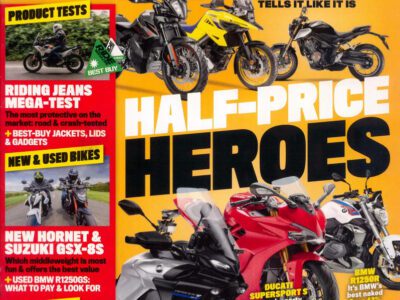I was riding my GSX-R600 along one of my favourite roads in May of this year, when both wheels shot out from underneath me as I was braking to set myself up for a corner. I fractured my shoulder and wrist and can’t work while they heal. On the Friday before, the road had been ‘surfaced dressed’ and had loose chippings all over it.
My insurers put me in touch with some claims outfit but it seems that as my claim doesn’t involve another driver no-one can help me. They also advised me that I should have been looking where I was going, seen the chippings and warning signs. I hit the only warning sign so I think it was a bit late.
The Copper who turned up was great, noting the gravel and calling someone to clean the road. He made it clear that the road was dangerous. I’ve not seen his report yet but he told me it would say there was about 20mm of loose chippings and my tyre track through it was five metres long.
Name witheld
Coppers come up trumps sometimes, unlike the strategically shaved monkeys in suits you have got ‘advising’ you. They are wrong, and you could not have an easier road surface case. Their problem is they have to make a decision quickly otherwise they will be paying your insurer £800 for a claim they do not understand.
You have a claim and your copper has done the work to prove it. The law is easy. If someone puts material on the highway that causes danger (there is some argument as to whether or no the danger has to be foreseeable, but that is an interesting argument for lawyers, and no-one else) and you suffer a greater damage than other road users (your broken bones and bike qualify) then you have a case.
National standards say that following the redressing of the carriageway the road should be swept until it is clean as loose gravel is very dangerous for motorcyclists and notes that loose gravel gets channelled into dangerous accumulations by four wheeled traffic that pushes it into piles that make it impossible for motorcycles to maintain control. And the warning sign is a bit of a red herring as it warned you after you had fallen off. Even if it had been placed in a position where you could see it, it does not amount to a defence. Local Authorities cannot make the roads dangerous then say, ‘Tough luck. we put up a sign.’ The best they can hope for is a bit of blame fixing to you (about 20 per cent) but as the sign was placed after the dangerous accumulation of chippings, if I were you I would press on for 100 per cent.
The only word of warning I would give you is these cases tend to drag on. The Council will squabble with their subcontractors, contracts frequently go missing, each will blame the other so here is the White Dalton method. Sue them both, press on to trial, don’t flinch and see them in Court. Your case is pretty well rock solid.
Andrew Dalton
Chip and Bin – Fast Bikes Magazine September 2010
Andrew Dalton has been writing articles for Fast Bikes Magazine for a considerable period and have condensed what we believe are the most useful articles to you. White Dalton Motorcycle Solicitors deal with personal injury claims and our sister company, Motor Defence Solicitors, deal with any road traffic offences.











